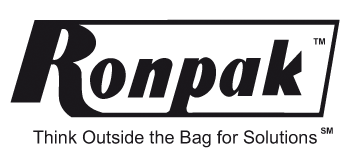16 Apr Biodegradability
biodegradability
What makes a product Biodegradable?
Most research data are based on end-of-life in the petroleum-based product cycle, although paper packaging will be the focus here. The word “decomposition” generally means “the act or process(es) of separating & breaking down elements (of a compound body) into its simpler parts over time.” Biodegradability could be considered a portion of overall commercial recycling goals in which Ronpak participates.
Composting, on the other hand, is generally thought of from an organic standpoint as microorganisms and metabolic processes are allowed to naturally reduce organic matter to its much simpler form.
“Compost” is usually associated with fertilizer for soil enrichment as its end result or “end-product,” while “biodegradable” refers to the eventual decomposition of a product by natural means. Manufactured paper packaging is better positioned to biodegrade successfully.
Paper packaging is also best suited for greater, faster compostability as paper degrades well along with the other most common compostable elements such as leaves, other yard waste, cardboard and food scraps – otherwise referred to as compost “feedstocks”.
Biodegradation occurs by way of various microorganisms (bacteria, fungi, worms, etc.) that enable the molecular breakdown of the disposed product. Bacteria and fungi are usually referred to as “flora”, as in the term “gut flora”, and work on breaking down a product through the use of chemical reactions, sunlight (UV) and oxygen.
“Recyclable”…”Compostable”…”Biodegradable”. Terms that have confused many when used interchangeably.
 Waste management or recycling facilities often find that many consumers are misled into buying & using products that are not nearly as green or eco-friendly as they claim, so it’s necessary to explain some key differences in terminology. ‘Biodegradable’ refers to a product breaking down into natural elements, carbon dioxide, and water vapor by organisms like bacteria and fungi. These biodegradable products break down much faster than other types of products and their break down results in carbon dioxide (CO2), water vapor & bits of organic material which is safe for the environment.
Waste management or recycling facilities often find that many consumers are misled into buying & using products that are not nearly as green or eco-friendly as they claim, so it’s necessary to explain some key differences in terminology. ‘Biodegradable’ refers to a product breaking down into natural elements, carbon dioxide, and water vapor by organisms like bacteria and fungi. These biodegradable products break down much faster than other types of products and their break down results in carbon dioxide (CO2), water vapor & bits of organic material which is safe for the environment.
‘Compostable’ indicates that a product will break down into natural elements, BUT within a municipal or industrial composting environment or facility. Compostable product materials are typically made from plants and other organic materials, such as corn starch or PLA plastic. Compostable products have some benefits over biodegradable options, namely, their break down occurs faster (sometimes as swiftly as 90 days) and they also break down into nutrient-rich products, which generates healthy soil for the planet.
Finally, ‘Degradable’ products (such as Single-Use plastic grocery bags) are mostly petroleum-based and break down via chemical reactions rather than organically by microorganisms. Unlike biodegradable items, degradable products can break down in anaerobic environments like typical municipal landfills. However, degradable products don’t break down completely, turning into organic material; they ultimately break apart into smaller, microscopic pieces which can still affect the environment to some degree.
Product packaging must be clear to the consumer who relies upon the manufacturers claims to be accurate.
The Federal Trade Commission states that (a) It is deceptive to misrepresent, directly or by implication, that a product or package is compostable. (b) A marketer claiming that an item is compostable should have competent and reliable scientific evidence that all the materials in the item will break down into, or otherwise become part of, usable compost (e.g., soil-conditioning material, mulch) in a safe and timely manner (i.e., in approximately the same time as the materials with which it is composted) in an appropriate composting facility, or in a home compost pile or device.
Ronpak working in conjunction with BPI –
As an eco-conscious packaging converter, Ronpak follows its own set of corporate initiatives designed to meet (& exceed) current industry regulations, such as adhering to the specifications of BPI for Compostability testing, as well as membership in the Sustainable Forestry Initiative (SFI). Currently Ronpak is pursuing its ISO 140001 Certification, which is a stringent set of regulations built for manufacturers working to meet their own Environmental Standard Quality Initiatives.
Ronpak utilizes BPI (North America’s leading certifier of compostable products & packaging) Compostability testing services to review and certify that all Ronpak-produced client packaging containers and paper products adhere to Compostable requirements for food packaging. Compostability begins as packaging products reach their “end of life”. For Ronpak-produced packaging, the bag artwork carries the “Compostable” logo as well as the “How-2-Recycle” stamp.
ASTM “Biodegradability” Specifications –
The ASTM D6400 Biodegradable specification details the guidelines for plastics and plastics-made products that are intended to be composted at a products’ end of life cycle at a city or commercial aerobic composting facility. The D6400 guidelines also cover proper labeling requirements for manufactured products and detail the specific requirements such as the rate of biodegradation and finally the viability of created compost that contains such biodegradable plastic(s) products.
The ASTM D6868 Biodegradable specification outlines regulations for biodegradable packaging or products that feature a layer of film that’s adhered to a paper base either via extrusion or lamination. D6868 Biodegradability requirements also expect that a product at its end of life stage will be composted with other materials in an industrial composting environment without any loss of value or utility of the resulting composted material.
“Breaking down” Biodegradability –
“Degradation” is the process that converts a plastic polymer to a monomer. Biodegradation happens when organic matter is broken down by microorganisms, such as bacteria, fungi. The process of Biodegradation can be divided into three general stages:
STAGE 1
- STAGE ONE -
BIODETERIORATION
STAGE 2
- STAGE 2 -
BIOFRAGMENTATION
STAGE 3
- STAGE 3 -
ASSIMILATION
Consumer consciousness –
As consumers become more educated about sustainability efforts, seeking to reward brands that commit themselves to a greener environment, Ronpak maintains its commitment to a smaller footprint, more efficient material use & tighter controls with its water and waste.
More food packaging customers actively seek fiber-based solutions for their new packaging – via paperboard or natural mold-pulp packaging. Today’s food industry continues to move foam packaging into the past. Natural and paper molded packaging offer superior functionality and strength where “microwavability” or “ovenability” is a key aspect for the end user. Stronger paper packaging also creates more durable containers for delivery needs. And, kraft paper products offer that immediate “visual sustainable cue” as end users associate kraft packaging with a cleaner environment.
 “Perhaps though the most important trend concerns the consumer and the consumer understanding and expectation. Quite simply, we have a different consumer today, with a different level of environmental consciousness. The consumer today wants to do something. There is an imperative.
“Perhaps though the most important trend concerns the consumer and the consumer understanding and expectation. Quite simply, we have a different consumer today, with a different level of environmental consciousness. The consumer today wants to do something. There is an imperative.
The consumer wants to make choices & believes that the purchasing choices can actually drive policy, make a significant or meaningful impact on the environment, and that is the expectation of the consumer.”
– David Mallen, National Advertising Division (NAD) Page 41, from the “Green Packaging Claims” seminar at the Federal Trade Commission on April 30, 2008.


